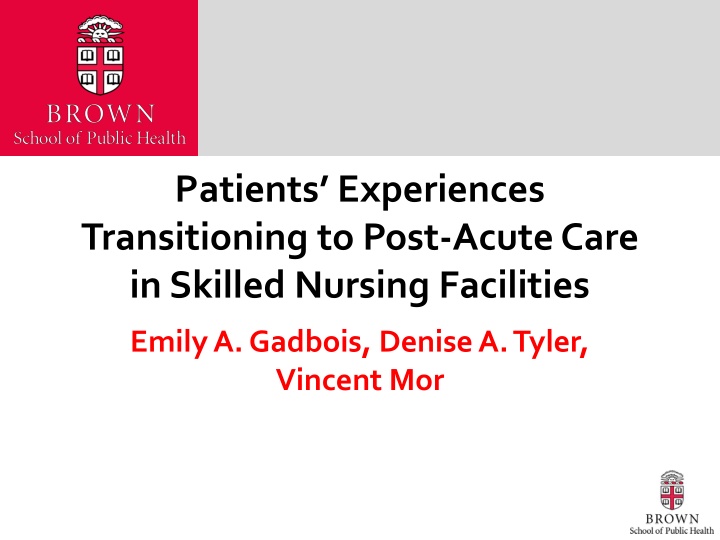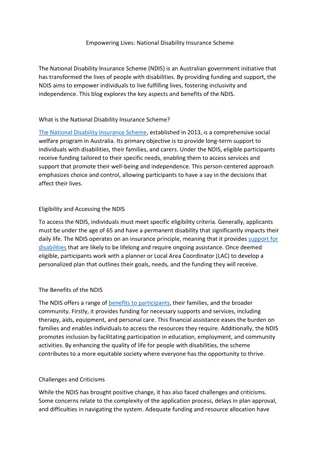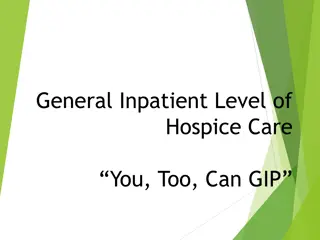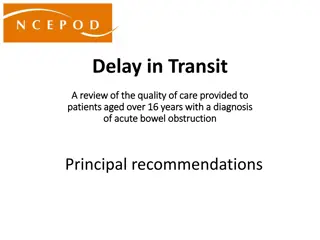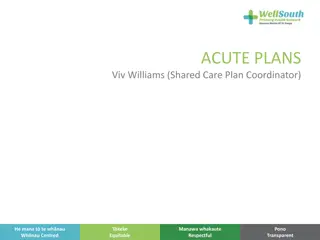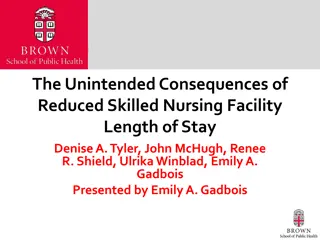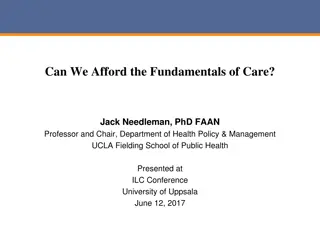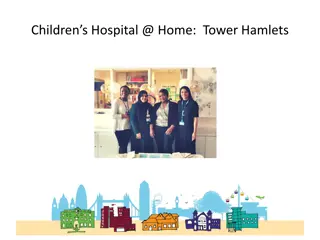Patients' Experiences Transitioning to Post-Acute Care in Skilled Nursing Facilities
This research project aims to understand the patient experience during the hospital discharge planning and skilled nursing facility (SNF) placement process. It explores the information patients use to make decisions and factors they consider important in selecting their SNF. The study sheds light on the limited knowledge regarding patients transitioning from hospitals to SNFs, how they exercise choice, and whether their choices are acknowledged and valued.
Download Presentation

Please find below an Image/Link to download the presentation.
The content on the website is provided AS IS for your information and personal use only. It may not be sold, licensed, or shared on other websites without obtaining consent from the author.If you encounter any issues during the download, it is possible that the publisher has removed the file from their server.
You are allowed to download the files provided on this website for personal or commercial use, subject to the condition that they are used lawfully. All files are the property of their respective owners.
The content on the website is provided AS IS for your information and personal use only. It may not be sold, licensed, or shared on other websites without obtaining consent from the author.
E N D
Presentation Transcript
Patients Experiences Transitioning to Post-Acute Care in Skilled Nursing Facilities Emily A. Gadbois, Denise A. Tyler, Vincent Mor
Acknowledgments Commonwealth Fund (Grant #5290040) NIA Program Project (Grant #AG-027296)
Research Objective To understand the experience of patients during the hospital discharge planning and skilled nursing facility (SNF) placement process, including the information patients use to make decisions and which factors they view as important in determining their selection
Background Post-acute care (PAC) often necessary following a hospital stay Since Affordable Care Act implementation, hospitals have become more responsible for PAC, including financial penalties for rehospitalizations We know little about patients experiences transitioning from hospitals to SNFs, how they exercise choice, and whether their choices are acknowledged and valued
Background: Patient Choice Research is limited, but consumers generally prefer providers that are closer to their homes But they are willing to travel somewhat further for better quality of care Nursing home attributes, such as profit status and hospital affiliation, are related to consumer choice Studies in other settings have demonstrated that education level, income, race, age, insurance status, and health conditions influence choice of providers
Background: Quality Measures and Public Reporting Research on patients use of quality measures and public reporting tools is particularly limited Patients may not be aware of publicly-reported information or have time to access it Patients may not have the skills necessary to access the reports, or to make sense of information not easily interpreted by lay audiences investments in hotel amenities more associated with patient choice than clinical quality scores strongest determinant of which SNF is chosen is distance from patients prior living arrangements
Background: Chaotic Transitions Nursing home quality reporting especially important for individuals who seek PAC after hospital event Making choices at a crisis point Nursing facility placement usually not planned Time pressure constrains individuals ability to collect information, which may have adverse consequences for outcomes Since post-acute admissions make up a large proportion of nursing facility admissions, how consumers choose their PAC setting is particularly important
Research Questions How do patients and families make decisions about which SNF to select? Source(s) of information they are aware of and which of these do they consider trustworthy and useful? Role of the hospital discharge planner (DP) in selecting a SNF? Types of information DPs use and provide to patients and families? Patient willingness to travel further from home if recommended by doctor or DP?
Methods Interviewed 98 SNF patients and/or family members in 5 health care markets 3 SNFs in each market (2 in the smallest) 7 previously community-dwelling, newly- admitted patients discharged from a hospital and/or their family members Interviews were recorded, transcribed, and qualitatively coded
Demographics 98 interviews, split among NE, S, MW, NW 60 female, 38 male 84 White, 11 Black, 3 other race 81 entered hospital on emergency basis (17 planned hospitalizations) 9 of 17 chose SNF in advance Patient was decision-maker in 66 cases, family/friend in 19 cases, hospital staff in 12 cases 35 patients had prior stay in same SNF 45 had never had any SNF stay
Results: Overview Little time to make decisions Patients received lists with just SNF names/addresses DPs and doctors minimally involved Most patients selected facilities they had previously been to, that family/friends had been to, or that were located close to home Most would go elsewhere if recommended Most felt overwhelmed with decision-making process
Results: Time to Decide Respondents required by DPs to make decisions regarding SNF placement quickly They wanted to move me out the same day. And so I had to decide so that they could go forward to see if they could get a bed. They were telling me we could leave the next day. So I went out and tried to find places. And then she had to have a transfusion, which kept her in there for a little bit longer. And that gave me enough time to kind of have a choice.
Results: Patients Received a Large List Respondents received a list of every facility in their area Well, they gave me a sheet with about 50 on there, but I looked for ones that were in my area so I wouldn't have to drive so far and this is the closest one that had an opening. The name, yeah that's all that was on there. They gave my daughter a whole sheet with facilities that we could choose from. And we looked at the addresses.
Results: Patients Received a Few Options Or received a short list of SNF options They were sorted by location where each one is located, but she went in and checked with my insurance, and she gave me the facilities that took my insurance. Oh they named a couple of different places, but I can t remember which ones they named, but when they mentioned this one I told them this one right here because it s closer to home.
Results: Role of Discharge Planners DPs were minimally involved She never recommended one over the other. I asked her which one she would choose and she said I'm not allowed to do that. They don t try to slant your opinion. They re very informative and very nice, and help expedite it. But I don t think they would ve helped me decide.
Results: Role of Physicians Physicians largely were not involved I didn't ask them for help. I mean they knew that I knew something about such facilities in the area, but I think they wanted to stick to the medical side of things. No, she doesn t do that. She s just a surgeon. Yeah.
Results: Location A common predictor of patients decisions included location Everything is location. This one is much closer. Location, location number one and their qualifications, but I was hoping they had good qualifications, but right now it was really location because my niece really doesn t drive too far.
Results: Prior Experience Another common predictor was previous experience Um, but I got to tell you, I even thought about [choosing another facility], but I kept coming back to the devil you know is better than the devil you don't know. So you gotta think what ya don't know, you're a little bit afraid of!
Results: Family/Friend Experience Respondents also chose facilities they knew others had stayed in Word of mouth is the best way. Probably to know somebody who was cared for at the place, because the brochures don t tell you anything. These people try to fill their places up, and there s a lot of hype in there. I like word of mouth of people who've already been there because the doctor, they're not lying in the bed, they haven't been where you've been.
Results: Help from Family/Friends Some relied on decision-making support from their family and friends Well, my daughter took care of a lot of those things for me and I think they were very helpful to her because my daughter will ask a lot of questions and she can be pretty feisty and aggressive at getting the information that she wants. No, they chose it for me and I was glad.
Results: Willingness to Travel Further Most would have traveled further to a higher quality facility or to one recommended by their doctor I would go anywhere if I thought they could help cure me or help facilitate my rehab. Oh, yes! I want to go to the best of the best.
Results: Feelings about the Process Many described the process as overwhelming There s some things you just have to go through to understand them...I tell you, you feel like you re on your own in most of these situations, I mean, I ve never been faced with it before...And then when I was put into the situation of making the decisions, and then for somebody to come up and say, well, It could be tomorrow, you gottago. Where do we go, you know? Oh, I got on meds at that time, to be able to handle all this...I think everybody needs to go through this process to know what us caregivers are going through, because it s crazy. Crazy.
Conclusions Results indicate that SNF placement is a stressful transition, and patients are not receiving significant guidance from DPs Although respondents would have appreciated help from DPs, hospital staff were very minimally involved Lack of guidance may be the result of misinterpretation of patient choice statutes embedded in Social Security and Medicare, which require that providers ensure patients rights to freely choose their Medicare providers Focus on providing choice at the expense of providing information
Conclusions Future research should investigate how the provision of data to patients influences choices and outcomes, what is the best type of data to provide, how this data might be formatted and structured Hospitals must consider how DPs can engage patients in decision-making that incorporates quality of care while still adhering to patient choice requirements
Conclusions SNF placement is a stressful transition, occurring when patients are physically vulnerable, and often without significant help from experienced professionals Most patients select a facility based on location because they are provided with no quality information or advice Hospitals increasingly responsible for outcomes experienced by patients post-discharge, yet discharge planning remains rushed and chaotic, and hospitals are failing to respond appropriately to improve care transitions and coordination
Thank You emily_gadbois@brown.edu
